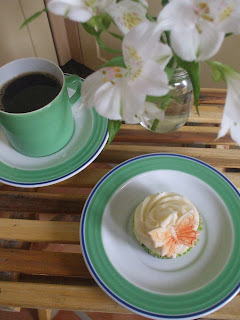Note: The cakes shown on this blog are not new to anyone who knows my work. However, this article is here to kick of National Cupcake week. Over the next week I'll be making new cupcakes every day and putting them up on www.facebook.com/thisiskarenskitchen. I'll be blogging about my week of cakes (with pictures) next week.
I recently had a strange experience: I saw a display of
cupcakes that didn't make me hungry. This is very rare for any cake - most of
them look appetising to me - and I set about working out why. It could have
been the thick chocolate icing and glitter making them look slightly mucky, or
the fact they had clearly been rushed in finishing. But what was really
offputting was the size of them.
When I was young, we make fairy cakes: small, fun cakes that
were perfect with a beaker of milk. Then muffins came to town. Compared to
fairy cakes, muffins are huge but then they can be: they are made with oil, not
butter, they are far less sweet and they are not covered in icing.
When did the cupcake become the size of a muffin? There is a
general feeling with cakes that bigger is better but that's not true. With a
small iced fairy cake in front of me I feel I'm in for a treat, with a giant
muffin-sized one I feel intimidated. If I want a large cake I'll go for a slice
of something: Carrot cake, for example, or Victoria sponge. A cupcake, on the other hand, should be small but perfectly formed, indulgent but not excessive.
If I use an American cupcake recipe, I always get almost 50%
extra from the mix. I can only assume that American cupcakes are either muffin
sized or significantly larger - can anyone shed any light on this for me? A
rudimentary web search on the difference between the two seems to reach a
consensus that they are the same just with different names. However, many
people claim cupcakes are larger than fairy cakes. My favourite answer was: one
is made by Americans, the other by fairies.
This is why fairy cakes are better:
1. Cakes are very sweet. It may seem obvious, but too much
will leave you feeling full, queasy and dehydrated. A cupcake you can hold in
your hand and eat in three bites will make you happy and satisfied without bad
after effects.
2. You can go mad with the toppings. On a large cake, the
prospect of so much sugar is terrifying. On a small one, it's wonderful. A tall
swirl of icing on a fairy cake is still edible. Simple decoration looks better, and fancy decoration more impressive.
3. You can make more. 12 large cupcakes or 18 fairy cakes? I
know what I'm going for. Everything looks better in large quantities, and
design-wise they are far more pleasant to look at. Plus, you can feed more
people, and no-one feels bad eating two. In fact, with a large cupcake, nobody will want to eat two.
4. When doing fondant icing for a picture cake, you can
decorate on top of the cake and the icing becomes king. These Pac-Man cakes
look like a picture, not a big pile of cakes. The fondant is thick but the cake is the right size to make a perfect combination of light sponge and sweet fondant.
5. Flavour. The most important aspect of any cake. I love
making cakes from anything from beetroot to dark chocolate to fresh fruit. In a
small cake these flavours are king - you can taste every key ingredient. In a
muffin-sized cake with icing, they almost certainly just end up tasting
sugary.
And in case you need any more convincing, butter icing as
just that: butter. I'd hazard a guess that a fairy cake has around a teaspoon
of butter on top of it, a muffin sized one about two.
So I say bring back the fairy cake. Let us have a sweet treat
with our afternoon cuppa, not a massive dinner-threatening snack. A cake
children can hold and eat, not one they have to dissect and lick the icing off
first. Let us free ourselves from massive portions and get back to the Instagram-tinged
cakes of our childhoods. Let fairy cakes rule again.





















